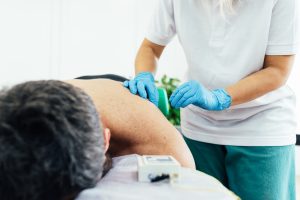What is Dry Needling? A Natural Way to Treat Pain
 The term “dry needling” might be intimidating when you first hear it. Most people have an aversion to needles due to having shots as a child or a painful reaction from an injection, and may even faint at the sight of needles. When talking about dry needling, don’t let the mention of needles worry you. It is called “dry” needling because nothing is injected into the body like medications, a vaccine, or pain-relieving medications like Lidocaine, Marcaine, or cortisone.
The term “dry needling” might be intimidating when you first hear it. Most people have an aversion to needles due to having shots as a child or a painful reaction from an injection, and may even faint at the sight of needles. When talking about dry needling, don’t let the mention of needles worry you. It is called “dry” needling because nothing is injected into the body like medications, a vaccine, or pain-relieving medications like Lidocaine, Marcaine, or cortisone.
Dry needling isn’t the same as getting an injection. Most patients find dry needling easy to tolerate once they get past the fear of the “needle” and find that it offers much-needed relief from knotted muscles or trigger points that cause pain after a repetitive overuse injury or trauma, like a fall. The pain from a tight and knotted muscle may go away on its own with conservative treatment at home (rest, massage, ice, heat, creams, etc), but many patients end up with ongoing pain that will need more extensive treatment from a professional.
Orthopaedic Hospital of Wisconsin physical therapist David Tranchita, MA, PT, OCS, CMTPT, CSCS is certified as a dry needling practitioner. He also is one of the first physical therapists in Wisconsin to be trained and certified by Myopain Seminars. He has an eclectic and holistic approach to patient care, using both traditional and alternative techniques, and performs dry needling in about 75 percent of his patients to get the best results. In the blog post below, Tranchita answers the most commonly asked questions about dry needling.
What is Dry Needling And is it Painful?

Dry needling is an invasive procedure in which a small needle is inserted into the skin and muscle aimed directly at the trigger point to relax the muscle, ease pain and restore movement. The needle disrupts muscle contractions, relaxes the tissues, and relieves pain. Dry needling also restores nerve function (i.e., reboots the system) and boosts healing by increasing blood flow to the injured area.
The needles used during this treatment are specially designed filament needles. Filament means “threadlike”, and these needles are thin and slightly tapered at the end. As a result, they smoothly glide through your skin and into the muscle without the feeling of a pin poke. Most patients don’t feel the needle but may feel sensations such as “pressure” and “twitching” after the needle is in the muscle. Most patients report the twitching feeling as “nervy” or “shocking” and only lasts a second or two.
What is a Trigger Point?
A trigger point is a small area of knotted fibers that develops when a specific area of your muscle fails to relax. Instead of being relaxed, the muscle fibers stay in an ongoing contraction that places pressure on nerve endings and constricts blood vessels, causing hypoxia (lack of oxygen) and ischemia (lack of blood flow) which is part of the pain cycle.
Trigger points typically develop when you overuse or strain your muscles. A few of the most common causes include repetitive muscle movements (i.e., typing, lifting, gripping), poor posture at work or driving long periods, lifting heavy objects, and a muscle injury from trauma (i.e., contusion from a fall).
You can also end up with a trigger point if you don’t get enough exercise, you spend a long time sitting, or you’re on bed rest. Without activity, muscles become weak and easily strained. As a result, they’re susceptible to developing trigger points. No matter what causes your trigger point, dry needling effectively relaxes the muscle and relieves the primary symptom – pain.
Trigger points are notorious for causing pain. Most people experience intense pain when they touch the knot or use the muscle. The pain can persist even when you rest the muscle. It’s also common for a trigger point to cause pain that radiates to another part of your body. The combination of pain and muscle tightness often restricts your movement. As dry needling takes effect, your pain goes away, and your range of motion improves slowly after each treatment.
What Types of Conditions Can Be Treated with Dry Needling?
Dry needling can be used for a variety of musculoskeletal conditions. Dry needling is appropriate for both acute and chronic conditions. Conditions include, but are not limited to, neck pain, headaches, lower back pain, sciatica, shoulder pain, tendinitis, tennis and golfer’s elbow, carpal and tarsal tunnel, jaw and ear pain, TMJ dysfunction, general muscle strains, and cramping. Dry needling can also ease chronic pain conditions such as myofascial pain syndrome and fibromyalgia. Myofascial pain syndrome, a common cause of generalized musculoskeletal pain, occurs when multiple trigger points develop in the fascia. The fascia is a connective tissue that surrounds and holds every muscle, nerve, blood vessel, and organ in your body. It also contains nerves, making it just as sensitive to trigger points as your muscles.
Fibromyalgia is known for two hallmark symptoms. The chronic condition causes widespread pain and tender muscles and intense body fatigue that doesn’t get better with sleep. Most people with fibromyalgia also have other comorbidities, stress, psychological issues, and trouble concentrating with memory problems. Though trigger points don’t cause fibromyalgia, it’s common for people with this condition to develop trigger points. Dry needling effectively reduces pain and improves some of the fibromyalgia symptoms (i.e., pain), and tends to sleep better and regain energy after each dry needling session.
What are the Risks of Dry Needling?
Though unlikely, there are risks associated with this treatment. The needles are very small and do not have a cutting edge. The likelihood of any significant tissue trauma due to dry needling is unlikely. Bruising is more common, but not a concern unless that patient takes blood thinners. In this case, the practitioner needs to take more precautions. The most serious risk associated with dry needling is accidental puncture of an organ, specifically the lungs when working on muscles along the rib cage but is a rare occurrence. Other less severe side effects include a mild skin infection, nerve irritation, and/or bruising from vascular bleeding.
What Side Effects Can I Expect After Treatment?
Most patients report being tired and sore after the procedure. The muscles will feel“bruised” for 1 to 2 hours. Then, a delayed onset of muscle soreness will last 24 to 48 hours. The sensation is similar to the effect of working out at the health club when you add a new exercise to muscles that are not used to the stress.
What Should I Do After Having Dry Needling Treatment?
Recommendations vary depending on the amount of soreness you have and on the individual response to the treatment. First, hydrate by drinking plenty of water, as your muscles are 70 percent water, and dehydration causes muscle cramps and more soreness. Other recommendations may include applying moist heat or ice over the area and doing gentle stretches for the activated muscles. There are usually no restrictions on your activity level, but if you start to feel better, don’t overdo it.
How Long Does it Take for the Treatment to Work?
Typically, it takes several visits for a positive reaction to take place, especially if you have a chronic (long-term) condition. Again, we are trying to cause changes in the tissue without any medications, therefore, we are looking for a response over several treatments to disrupt the pain cycle.
Why is my Doctor Not Familiar With Dry Needling?
In the United States, dry needling is a relatively new method for treating pain, and not everyone is aware of this effective treatment. The Orthopaedic Hospital of Wisconsin physical therapists work and communicate closely with referring physicians and incorporate it into your plan of care as appropriate.
Where Does Dry Needling Fit Into the Whole Rehabilitation Program?
Dry needling is one treatment option for targeting muscles that are overworked. Dry needling is often used early in your therapy with manual therapy to get the best results. Once the muscle has been “reset”, your physical therapist will work with you using other techniques such as stretching, strengthening exercises, postural training, and ergonomics to retrain your body to maintain a normal state and restore optimal function for your everyday life.
Once I Feel Better, How Often Do I Need to Come Back to Maintain Progress?
The musculoskeletal system is under constant pressure from gravity, stress, work, etc. A regular exercise program combined with good posture can prevent many problems. If the pain comes back, “tune-ups” are recommended to treat them and reset the muscles again. Most patients go onto a maintenance program (once a week to once a month). This is similar to what people do with massage therapy, chiropractic, or acupuncture to help keep things at bay.
What Training is Required to Perform Dry Needling?
Each state varies on the amount of training and certifications for who can perform dry needling. Physical therapists at Orthopaedic Hospital of Wisconsin are not licensed acupuncturists and do not practice acupuncture. They are licensed physical therapists who have dry needling as part of their practice. They also get advanced training in technique and include it as part of their treatment plan. In contrast to most schools of acupuncture, dry needling is based on Western medicine principles and research. Its goal is to reduce specific trigger point activity found within overused muscles and the surrounding tissues.
To see if dry needling is an appropriate treatment for your condition, call the Orthopaedic Hospital of Wisconsin at (414) 961-6800 or go online to schedule an evaluation with one of our experienced physical therapists.

